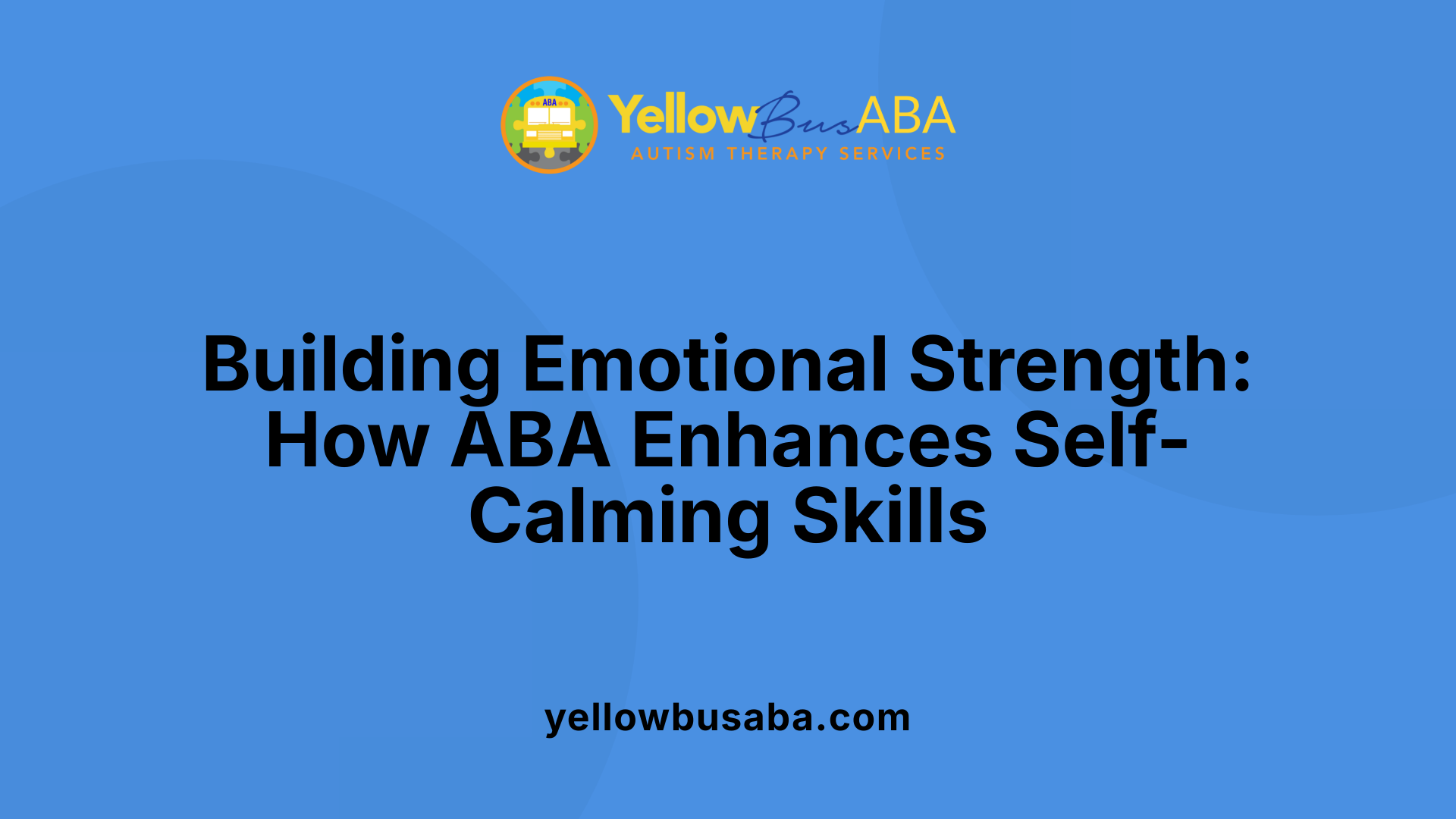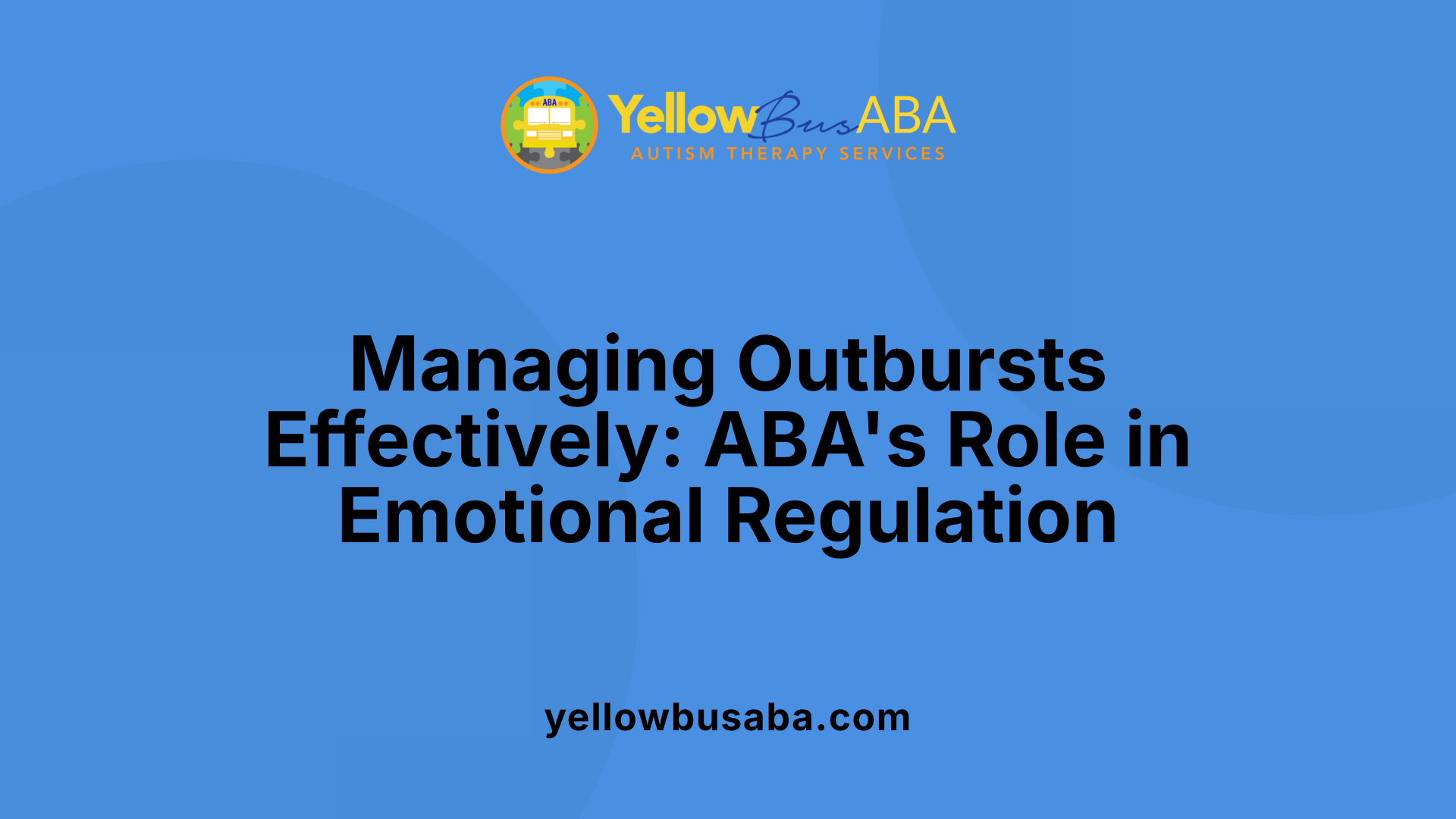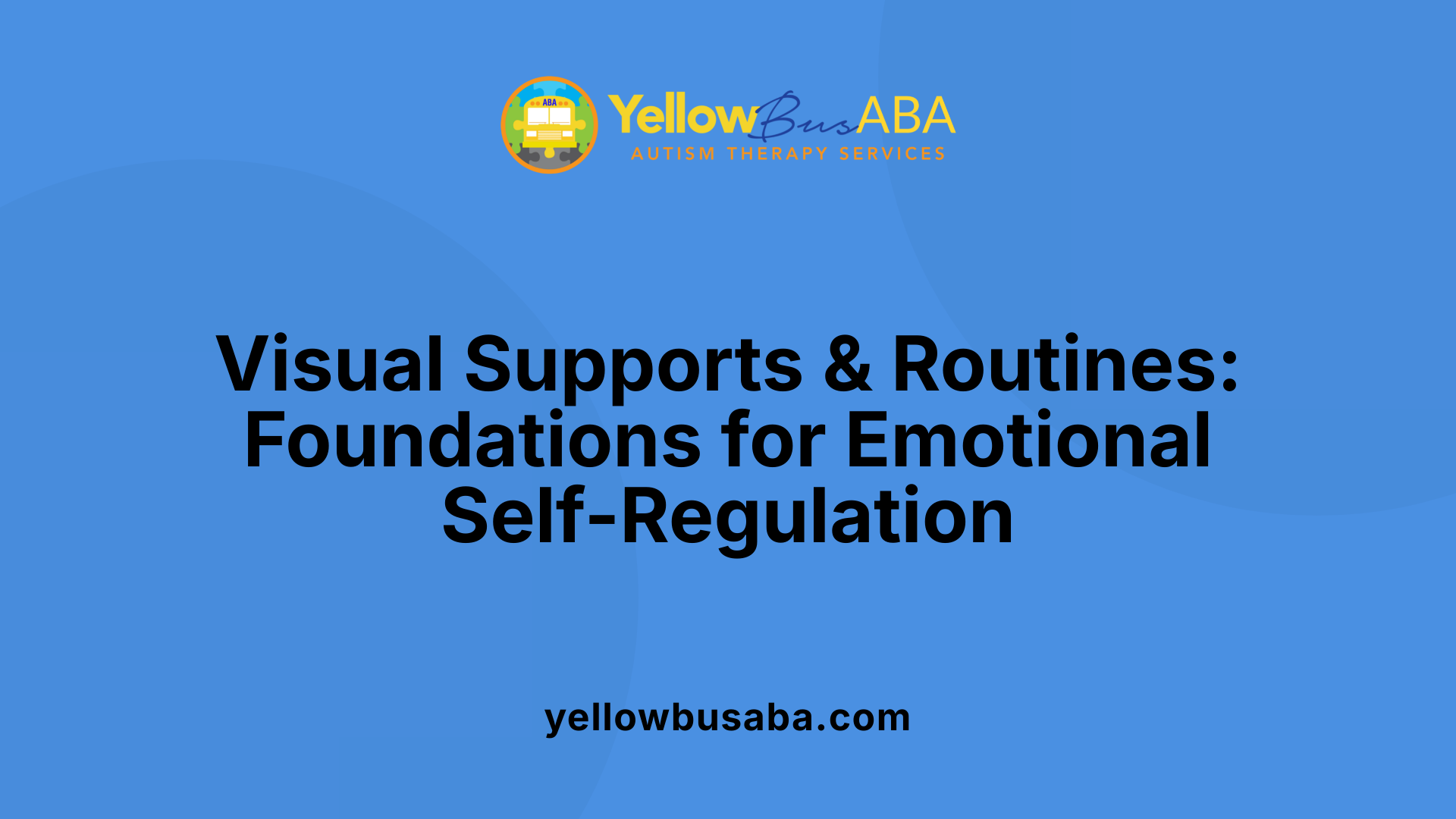Understanding ABA’s Impact on Emotional Regulation
Applied Behavior Analysis (ABA) therapy has long been recognized as an effective intervention for children with autism and related conditions. Beyond improving communication and social skills, ABA plays a pivotal role in teaching self-calming techniques, which are essential for emotional regulation and overall well-being. This article explores how ABA therapy systematically develops these skills through evidence-based strategies, contributing significantly to managing emotional outbursts, fostering independence, and enhancing resilience.
The Foundation of ABA in Skill Development

What is known about the effectiveness of ABA therapy in skill development for self-calming?
Research shows that ABA (Applied Behavior Analysis) therapy is highly effective at helping children with autism develop self-calming and emotional regulation skills. These strategies are a core component of many ABA programs, tailored to meet each child's unique needs.
ABA therapy uses structured, evidence-based techniques such as teaching coping mechanisms like deep breathing, muscle relaxation, and sensory tools. Visual aids like social stories and emotion charts are frequently employed to enhance emotional awareness and understanding.
Reinforcement plays a critical role in encouraging children to adopt self-control behaviors. For instance, children are rewarded for calm responses to frustration with praise, tokens, or preferred activities. This positive reinforcement helps establish desired behaviors and promotes independence.
Through role-playing and modeling, children are given opportunities to practice emotional regulation in simulated real-life situations. These activities help them understand and manage triggers such as noisy environments or sudden changes, making them more adaptable.
Evidence from research, including multivariate analyses, demonstrates significant improvements not only in emotional regulation but also in social and communicative abilities—skills that are closely related to self-calming. These advancements contribute to reducing anxiety and distress, especially relevant for children with additional challenges like asthma.
The individualized approach of ABA ensures that interventions are tailored precisely to a child's current abilities and challenges. Consistent practice across different settings—home, school, and community—further supports skill generalization and maintenance.
Overall, ABA therapy's systematic use of reinforcement, visual supports, and structured teaching leads to meaningful gains in self-regulation, helping children manage their emotions more effectively and fostering greater independence.
Teaching Self-Regulation Through Evidence-Based Strategies

How does ABA therapy help children develop self-regulation and emotional regulation skills?
ABA therapy uses proven methods to help children manage their emotions and behaviors. One of the main strategies involves positive reinforcement, where children receive praise, tokens, or preferred activities when they show calm or appropriate responses. This encourages them to repeat these behaviors.
Modeling and role-playing are also crucial. Therapists demonstrate calming techniques, such as deep breathing or using visual tools, then guide children to practice these skills. Visual aids like emotion charts and social stories help children recognize and label their feelings, building emotional awareness.
To prepare children for real-life situations, ABA incorporates activities like problem-solving exercises and video modeling. These practice scenarios enable children to rehearse coping strategies, ensuring they can apply them across different environments.
ABA therapy also includes teaching calming methods like sensory activities, muscle relaxation, and structured routines. These routines help reduce anxiety and sensory sensitivities, supporting emotional stability.
Through regular assessments and consistent reinforcement, ABA fosters independence and resilience. The approach aims to develop children’s ability to recognize, understand, and regulate their emotions effectively, promoting social-emotional growth and success in daily life.
How does ABA therapy incorporate visual aids and practical activities?
Visual supports such as emotion charts, stoplight systems, and social stories are used to help children identify their feelings. These tools enhance emotional vocabulary and help children understand the connection between emotions and behaviors.
Practical activities like role-playing and imitation exercises enable children to practice calming strategies in simulated situations. These activities reinforce the skills needed to manage feelings of being overwhelmed or upset.
Combining visual and hands-on approaches makes learning about emotions engaging and effective, preparing children to use these skills in real-world settings.
What are the main topics covered?
| Strategies Used | Description | Benefits |
|---|---|---|
| Positive Reinforcement | Rewards for desired behaviors | Encourages repetition of calm and appropriate responses |
| Modeling and Role-Playing | Demonstrating and practicing calming techniques | Builds confidence and skill transfer |
| Visual Aids and Social Stories | Using visual tools to teach emotion recognition | Improves emotional vocabulary and awareness |
| Calming Techniques | Deep breathing, sensory activities, structured routines | Reduces anxiety and sensory overload |
| Personalized Assessments | Tailoring strategies to individual needs | Ensures effective, relevant support |
This evidence-based approach helps children with autism develop self-regulation skills, leading to better emotional management and greater independence.
Managing Emotional Outbursts with ABA Techniques

How does ABA therapy impact managing emotional outbursts and promoting emotional regulation?
ABA therapy plays a crucial role in helping children manage emotional outbursts by providing a structured and evidence-based approach. It begins with identifying specific triggers that cause frustration or distress through Functional Behavior Assessments (FBAs). Understanding what prompts these reactions allows therapists to create personalized intervention plans tailored to each child's needs.
Part of this plan involves teaching children coping strategies, such as relaxation methods, sensory breaks, and self-regulation techniques. For example, children may learn deep breathing exercises, visual aids like emotion charts, or calming activities like squeezing a stress ball or listening to soothing music. These tools help them recognize their feelings early and respond in a balanced way.
Positive reinforcement is a core component of ABA, rewarding desirable behaviors like calm responses and appropriate communication. This encouragement boosts confidence and reduces episodes of frustration or anger. Additionally, ABA supports improving language skills, enabling children to express their emotions clearly, which further decreases emotional outbursts.
Modeling, role-playing, and social stories are used to practice emotional regulation skills in safe environments. Consistent practice at home and school helps generalize these strategies, fostering resilience and independence. Overall, ABA creates a supportive framework that nurtures emotional awareness and self-control, essential for long-term success and well-being.
Teaching Self-Calming Strategies in Practice
What strategies and methods are used by ABA therapy to teach self-calming techniques?
ABA therapy uses a range of evidence-based approaches to help children develop effective self-calming skills. One of the primary methods involves modeling behaviors through role-playing, social stories, and video modeling. These techniques allow children to observe calming behaviors in a controlled setting and then practice imitating them.
Visual supports play a crucial role in teaching emotional regulation. Tools like feelings charts and stoplight systems help children identify and understand their emotional states, making it easier to select appropriate calming strategies. Additionally, sensory tools such as stress balls, textured items, or calming bottles are introduced to aid relaxation.
Reinforcement schedules reinforce positive behavior. Praise, tokens, or access to preferred activities motivate children to use their calming techniques regularly. Importantly, teaching these skills during calm moments, when children are more receptive, increases the likelihood they will apply them during times of stress.
Prevention and proactive strategies are essential components. Visual routines and schedules, offering choices, and teaching coping skills like deep breathing or using a designated calming space help prepare children to manage their emotions effectively during emotional surges.
By integrating these methods, ABA therapy builds a foundation of self-awareness and emotional regulation, empowering children to handle stressful situations independently and confidently.
The Role of Visual Aids and Routine Building
 ABA therapy utilizes various visual aids and structured routines to promote emotional regulation and self-calming skills in children with autism. Among these tools, emotion charts, social stories, and stoplight systems are particularly effective.
ABA therapy utilizes various visual aids and structured routines to promote emotional regulation and self-calming skills in children with autism. Among these tools, emotion charts, social stories, and stoplight systems are particularly effective.
Emotion charts help children identify and understand different feelings by visually representing emotions through pictures or symbols. This enables children to recognize their own emotional states and communicate them effectively. Social stories provide tailored scenarios that teach appropriate responses to various situations, including how to manage feelings of frustration, anxiety, or overstimulation.
Stoplight systems are visual cues—typically using red, yellow, and green lights—that guide children in assessing their emotional or behavioral states. Green indicates a calm and ready state, yellow signals caution or increasing stress, and red suggests a need for calming techniques or a break.
Teaching children to recognize and label their feelings is foundational for emotional awareness. Using visual supports makes abstract emotional concepts concrete and accessible, enhancing vocabulary and self-understanding.
Developing calming routines is another crucial aspect. These routines are practiced during calm moments, so children are prepared to rely on them during times of emotional distress. Examples include balloon breathing, pretzel squeezing, or gentle movement activities like walking.
Reinforcing these behaviors with positive rewards encourages children to adopt and maintain self-regulation strategies. Consistent practice in safe settings builds resilience and independence.
Incorporating these tools and routines in daily life helps children manage stress proactively, reduces emotional outbursts, and fosters a sense of security. The visual supports serve as cues for self-calming actions, making emotional regulation a tangible and achievable goal.
Integrating Calming Techniques with Daily Routines and Environment
What is the role of ABA therapy in teaching self-calming techniques for children with autism?
ABA therapy is instrumental in helping children with autism develop self-calming skills. Through personalized and structured interventions, ABA therapists teach a variety of calming methods tailored to each child's needs and preferences.
A core component of ABA involves positive reinforcement, which encourages children to adopt self-regulation techniques such as deep breathing exercises, muscle relaxation, and sensory activities. These strategies are introduced gradually, often during calm moments, so children learn to use them effectively during times of emotional distress.
Visual supports like emotion charts, social stories, and tools such as a mood thermometer help children recognize and understand their feelings. These aids promote emotional awareness and serve as cues for applying calming techniques.
ABA also emphasizes building an interoceptive awareness—helping children recognize internal signals like increased heart rate or rapid breathing that indicate they are becoming overwhelmed. Recognizing these signs early allows for timely use of calming strategies.
Furthermore, ABA therapists collaborate with caregivers to create supportive environments. This includes setting up sensory-friendly spaces and establishing consistent routines, which bring predictability and a sense of security, thereby reducing triggers for anxiety or behavioral outbursts.
Practical calming activities taught in ABA include balloon breathing, pretend squeezing (pretzel squeezing), walking, singing, or hugging a favorite pillow. Practicing these during calm periods helps children use them independently when needed.
Overall, ABA therapy provides children with practical tools to self-regulate, manage stress, and navigate their environment with confidence. This fosters emotional resilience and reduces the likelihood of disruptive behaviors, supporting their growth toward independence and well-being.
Creating consistent routines and calming environments
Establishing routines is fundamental in ABA to support emotional stability. Consistent schedules help children know what to expect, reducing uncertainty and anxiety.
Routine activities, such as morning prep, homework time, or bedtime, can incorporate calming practices like deep breathing or visual check-ins with emotion charts. These predictable patterns create a calming framework that children can rely on.
Supportive environments include sensory-friendly spaces equipped with calming tools like soft lighting, noise-canceling headphones, or textured toys. These spaces serve as safe zones where children can retreat when overwhelmed.
Supporting self-regulation through environmental modifications
Adjustments in the environment can significantly impact a child's ability to self-regulate. Using visual cues such as stoplight systems or feelings charts can guide children to recognize their emotional states.
Reducing sensory overload by minimizing loud noises or bright lights during critical times can help children stay calm. Incorporating sensory tools like chewable jewelry, stress balls, or weighted blankets further aids regulation.
Teaching children to use calming strategies during daily life
Proactively teaching children to employ calming techniques during everyday activities ensures they are equipped to handle stress throughout the day.
Modeling and role-playing scenarios are effective methods for practicing these strategies. For example, children can rehearse asking for a break or using a calming app during a stressful situation.
Parents and teachers are encouraged to reinforce these skills consistently, linking practice during calm moments to their use in real-life situations. This consistency enhances skill generalization and confidence.
In conclusion, ABA therapy's focus on creating structured routines, modifying environments, and teaching practical calming techniques empowers children to manage their emotions effectively. These strategies support their overall development, independence, and emotional well-being, making daily life more manageable and less stressful.
Building Consistency and Supporting Caregivers
Why is consistency important across home, school, and therapy settings?
Consistency plays a vital role in the success of ABA therapy, especially when teaching children self-calming and emotional regulation skills. When behaviors and strategies are reinforced in all environments—at home, at school, and during therapy sessions—children receive clear, unified messages that help them understand expectations and responses.
This uniformity enhances skill generalization, meaning children are more likely to apply calming techniques in different contexts, reducing confusion and increasing independence. Additionally, consistent routines create a predictable environment, which can lower anxiety and promote emotional stability for children managing conditions like autism, ADHD, or asthma.
How can caregivers and school staff be trained in self-calming techniques?
Training caregivers and school staff is crucial for maintaining therapy goals outside of clinical sessions. ABA professionals typically provide hands-on coaching, demonstrations, and feedback to educators and parents. They teach strategies such as guided modeling, role-playing scenarios, and using social stories that depict calming behaviors.
Workshops and ongoing consultation enable caregivers and staff to learn visual and physical calming tools, like breathing exercises, sensory activities, or the use of visual aids. Empowered with these skills, they can support children consistently, reinforcing learned behaviors and encouraging self-regulation during everyday challenges.
What role do visual aids and activities play at home and in school?
Visual supports are fundamental tools in ABA to help children recognize and understand their emotional states. Feelings charts, stoplight systems, and social stories visually depict different emotions and appropriate responses.
Activities such as sensory play, guided breathing exercises, and calm corner routines are also incorporated to reinforce calming techniques. For example, teaching children to use a visual cue like a mood thermometer helps them identify when they are feeling upset and need to employ coping strategies.
Using visual aids and structured activities consistently across settings helps children develop a stronger understanding of emotional cues and self-regulation skills. These methods support proactive emotional management, decreasing the likelihood of emotional outbursts or stress-related behaviors.
Strategies and Methods Used by ABA Therapy to Teach Self-Calming Techniques
ABA therapy employs multiple approaches to teach self-calming effectively. These include:
- Modeling Behaviors: Through role-playing, social stories, and video demonstrations, children observe calming behaviors and practice replicating them.
- Visual Aids: Feelings charts, stoplight systems, sensory bottles, and calming tools help children identify emotions and select appropriate coping strategies.
- Reinforcement Systems: Praising or rewarding efforts to use calming strategies encourages continued practice.
- Teaching in Calm Moments: Skills are initially taught during relaxed times, increasing the likelihood they'll be used during stress.
- Preventative Strategies: Visual schedules and giving choices help children feel in control, reducing anxiety.
- Coping Skills Practice: Deep breathing, sensory activities, and calming spaces are integrated into routines.
All these methods aim to create positive routines and foster emotional independence.
Implementing Consistency and Training at Home and School
To ensure success, ABA programs emphasize caregiver participation. Training sessions often include teaching parents and teachers how to implement strategies like calm-down routines, visual supports, and reinforcement schedules.
Regular communication between therapists, caregivers, and school staff ensures strategies are applied uniformly. This might involve sharing progress notes, conducting joint training sessions, or providing resource materials like activity guides and visual aids.
By working together, caregivers and educators help embed self-calming techniques into daily routines, making these skills a natural part of children’s lives.
| Setting | Focus Areas | Support Strategies |
|---|---|---|
| Home | Routine consistency, emotional awareness, calming tools | Visual aids, guided practice, reinforcement, sensory play |
| School | Behavior management, self-advocacy, social stories | Staff training, visual supports, calm corners |
| Therapy Sessions | Skill teaching, modeling, reinforcement, data tracking | Role-playing, social stories, visual aids |
Final Thoughts
Building consistency across environments helps children internalize emotional regulation skills. Training caregivers and school staff to use visual aids and engage in structured activities ensures children get continuous support. This collaborative effort fosters resilience and independence, empowering children to manage emotions more effectively and navigate daily challenges with confidence.
Conclusion: The Impact of ABA in Fostering Emotional Resilience
What is known about the effectiveness of ABA therapy in skill development for self-calming?
Research has consistently shown that Applied Behavior Analysis (ABA) is highly effective in teaching children with autism how to manage their emotions and develop self-calming skills. Through structured and individualized interventions, ABA therapists utilize various techniques to improve emotional regulation.
One of the core strategies involves teaching children coping mechanisms such as deep breathing exercises, muscle relaxation, and sensory-based calming tools like stuffed animals or visual aids. Visual support tools like emotion charts and social stories are often used to enhance emotional awareness and vocabulary, enabling children to recognize their feelings and understand appropriate responses.
Reinforcement plays a vital role in these interventions. Desired behaviors—such as responding calmly to frustration—are positively reinforced through praise, tokens, or preferred activities. This encouragement helps children associate self-calming behaviors with positive outcomes, fostering consistency and motivation.
Techniques such as role-playing scenarios simulate real-life situations, allowing children to practice and rehearse calming strategies in a safe environment. Additionally, functional communication training (FCT) equips children with alternative ways to express their needs, thereby reducing emotional outbursts related to communication difficulties.
The overall goal of these interventions is to enhance emotional awareness, resilience, and the ability to tolerate transitions and changes more effectively. Studies utilizing multivariate analyses have documented significant progress across functional social, communication, and behavioral domains, indicating that ABA’s personalized, evidence-based approach supports meaningful development in self-regulation.
In summary, ABA therapy's comprehensive, tailored plans—integrating reinforcement, modeling, role-playing, visual supports, and self-regulation techniques—are proven to foster crucial emotional resilience and self-calming skills. These improvements contribute not only to reduced anxiety and distress but also to increased independence and overall well-being for children with autism.
Fostering Resilience and Independence
ABA therapy's structured, individualized approach plays a crucial role in teaching self-calming techniques that empower children with autism to manage their emotions effectively. Through consistent reinforcement, visual supports, modeling, and caregiver collaboration, ABA helps children develop essential skills for emotional regulation, reducing behavioral challenges and fostering independence. As part of a comprehensive intervention plan, ABA not only mitigates emotional outbursts but also builds resilience, resilience, and self-confidence, setting children on a path toward successful and fulfilling lives.
References
- How ABA Therapy Supports Children Living with Autism and Asthma
- From Meltdowns to Calm:ABA Therapy Strategies for Managing ...
- Teaching Children to Self-Regulate Their Emotions - ABA Therapy
- What is Emotional Regulation? Breaking Down the Basics for ABA ...
- Applied Behavior Analysis (ABA) | Autism Speaks
- Calming Strategies for Kids: Techniques to Teach to Children
- 10 ABA Calming Strategies for Kids! - Atlas Behavior Services



.jpg)

.avif)
